After you have exported Rooms and Resources databases information into the Migrator for Notes and matched them with their corresponding AD entries using the Match selected button in the Import and Copy view, you can prepare the Rooms and Resources for migration.
|
|
Be sure that room mailboxes have been created in Office 365 for rooms and/or resources. |
Expand Room & Resource Migration | Migration | Set Migration Profile in the Navigation Pane
Select rooms and resources in the Data Pane and click the Set CMT Migration Profile button:

Set Migration Profile View
Select the appropriate profile from the dialog box and click OK:
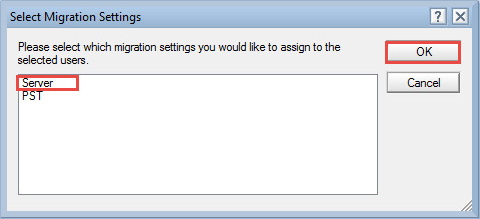
Before migrating, clear or delete any necessary databases; in the Advanced view, select the rooms and resources, click Additional Actions and select the appropriate drop-down menu item:
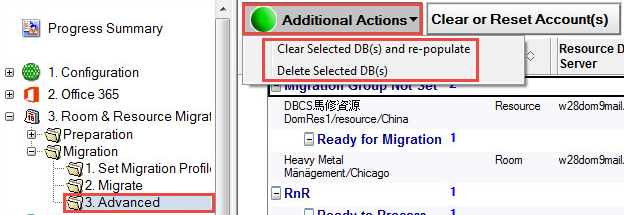
The following table describes the menu options:
|
Option |
Description |
|
Clear Selected DB(s) and re-populate |
Selected room or resource will be cleared and then repopulated to import the updated information |
|
Delete Selected DB(s) |
Selected room or resource will be deleted from the Migrator for Notes database as well as the database into which the rooms or resources schedule was exported |
After you have performed all the pre-migration actions on the rooms and resources, then go back to the Migrate view
Select all the rooms and resources you wish to migrate, and then click the Migrate Rooms & Resources button in the Data Pane toolbar:

The Select Migration Priority dialog box appears. Click OK to trigger the migration

Depending on the size of the data being migrated, the transfer may take from few minutes to several minutes.
The Refresh Migration Status button allows you to refresh the status of the selected rooms and resources.
Before migrating, clear or delete any necessary databases; in the Advanced view, select the rooms and resources, click Additional Actions and select the appropriate drop-down menu item:

The following table describes the menu options:
|
Option |
Description |
|
Clear Selected DB(s) and re-populate |
Selected room or resource import database created by Migrator for Notes will be cleared and then repopulated to import the updated information. This does not impact on the source Domino resource application |
|
Delete Selected DB(s) |
Selected room or resource will be deleted from the Migrator for Notes database as well as the temporary database created by Migrator for Notes into which the rooms or resources schedule was exported |
After you have exported Rooms & Resources databases information into the Migrator for Notes, create a migration profile for the rooms and resources to be migrated to a .pst file, and save it:
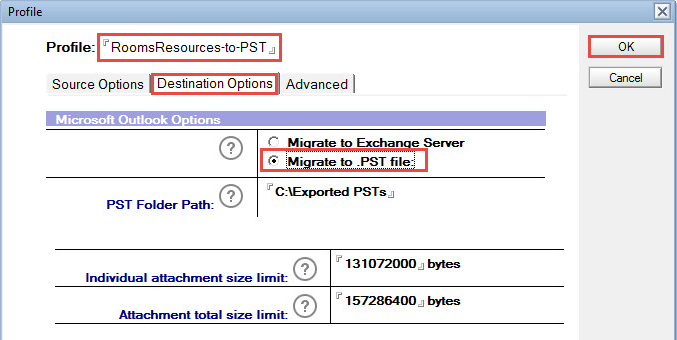
Configuration | Migration Profiles View
|
|
Be sure that room mailboxes have been created in Office 365 for rooms and resources if the migrated .pst data is to be imported. |
In the Navigation Pane, expand Rooms & Resources Migration | Migration under | Set Migration Profile view
Select rooms and resources in the Data Pane and click the Set CMT Migration Profile button:
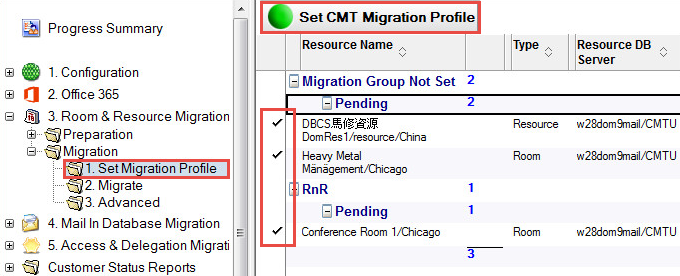
Rooms & Resources | Set Migration Profile View
Select the migration profile created earlier to migrate rooms and resources to a .pst file and click OK
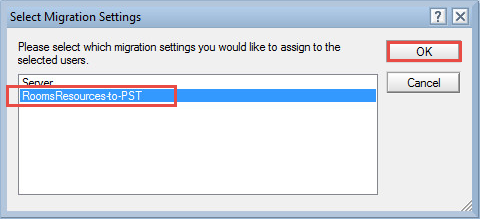
Click Migrate in the Navigation Pane
Select the room and resources in the Data Pane and click the Migrate Rooms & Resources button

Rooms & Resources | Migrate View
The Add to migration queue option is selected; click OK:
If the rooms and resources migrate successfully, group status will appear as “Migrated Successfully” in the Data Pane; the rooms and resources will also beexported to the C:\Exported PSTs folder:

For information on manually setting migration statuses, see Appendix E: Migration Result Statuses.
If you have already added all names to the Translation Table in a previous step, Mail-in databases are already there. If not, add them now by going back to the Email Repliability view. You can match these entries in either view as needed.
A Mail-in database can be migrated either to a .pst file or to the Exchange server.
The first step in the migration of a mail in database is to import it into Migrator for Notes and prepare it for migration.
Expand the Mail In Database Migration | Preparation | Import view in the Navigation Pane
Click Import Mail-in DBs:
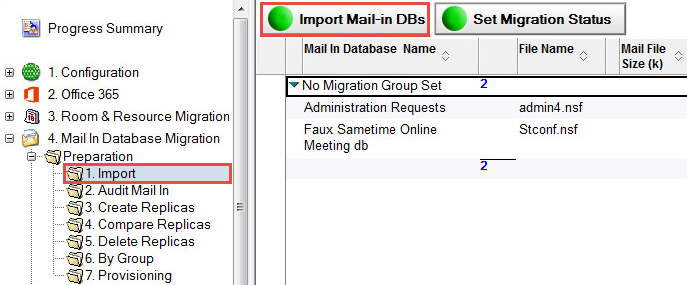
Mail In Database Migration | Import View
If the Select a Database dialog box appears, select the Domino Directory you want to use for the import; click OK
From the Mail-In Databases view in <Domino directory> dialog box, select the mail-in database that you want to migrate, and click OK:
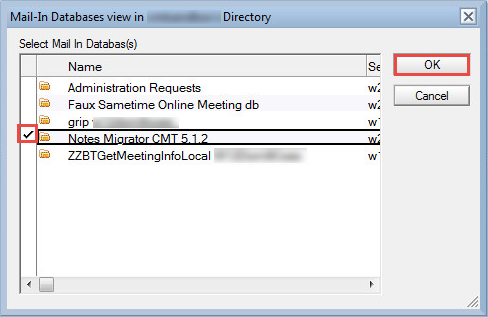
Click OK in the message box:
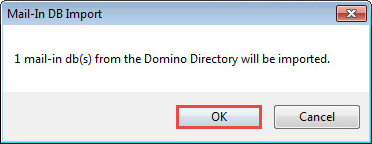
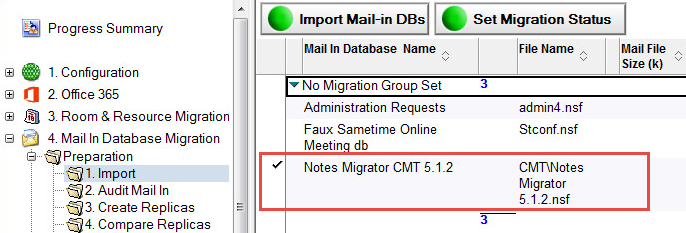
Mail-in database successfully imported
Next, click the Audit Mail In view on the Navigation Pane and select a database in the Data Pane to verify
Click the Verify Mail-In Database button:
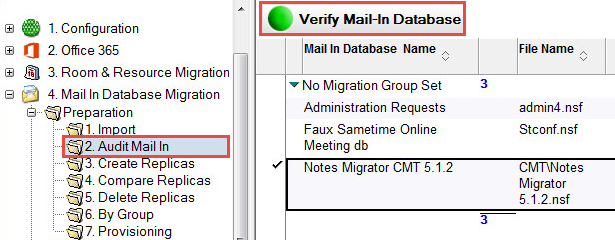
Audit Mail In View
Click Yes in the confirmation box:
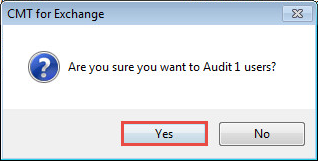
Click OK in the box that appears showing that the database has been audited
If you have already added all names to the Translation Table in a previous step, Mail-in databases are already there. If not, add them now by going back to the Email Repliability view. You can match these entries in either view as needed.
A Mail-in database can be migrated either to a .pst file or to the Exchange server.
The first step in the migration of a mail in database is to import it into Migrator for Notes and prepare it for migration.
Expand the Mail In Database Migration | Preparation | Import view in the Navigation Pane
Click Import Mail-in DBs:

Mail In Database Migration | Import View
If the Select a Database dialog box appears, select the Domino Directory you want to use for the import; click OK
From the Mail-In Databases view in <Domino directory> dialog box, select the mail-in database that you want to migrate, and click OK:

Click OK in the message box:


Mail-in database successfully imported
Next, click the Audit Mail In view on the Navigation Pane and select a database in the Data Pane to verify
Click the Verify Mail-In Database button:

Audit Mail In View
Click Yes in the confirmation box:

Click OK in the box that appears showing that the database has been audited